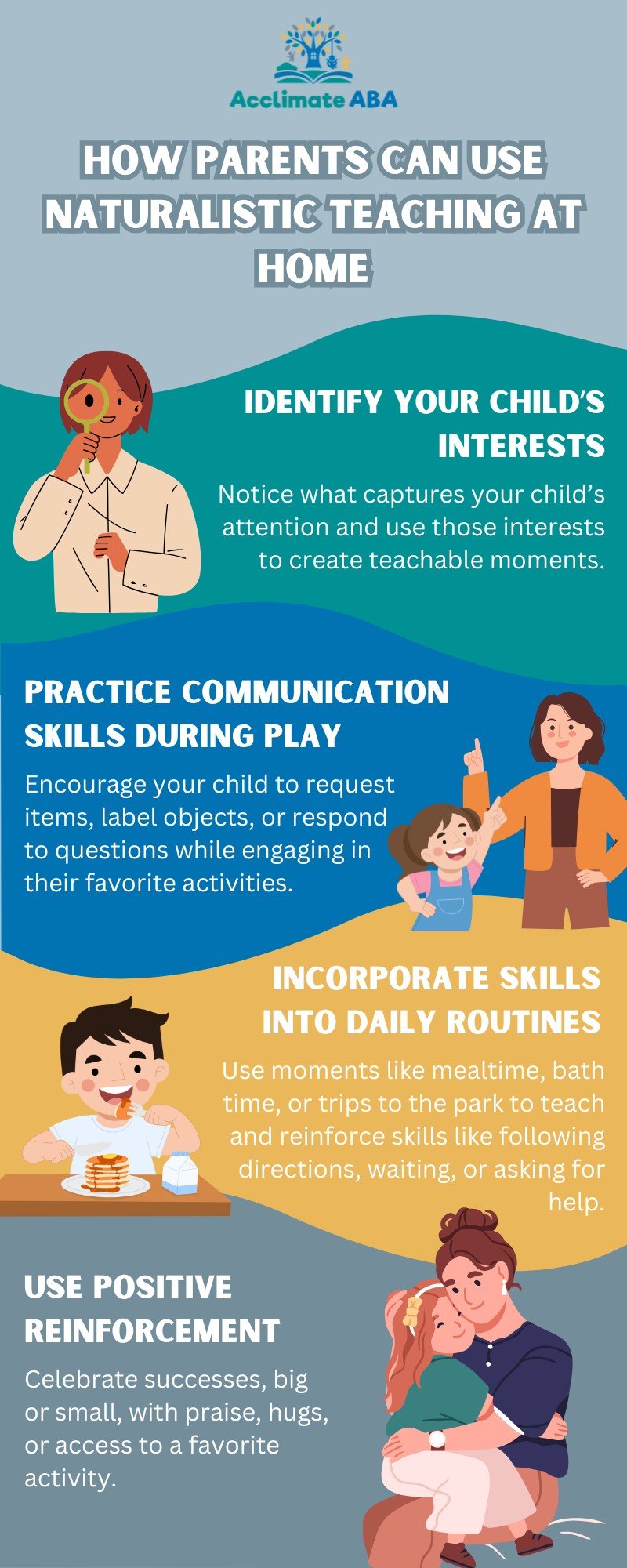Naturalistic Teaching in ABA: Strategies and Benefits

Key Points:
- Naturalistic teaching in ABA focuses on teaching within real-life, meaningful contexts.
- It encourages skill generalization by embedding learning opportunities into everyday activities.
- Strategies include child-led interactions, natural reinforcers, and incorporating the learner’s interests.
What if learning could feel like play and happen naturally during everyday activities? That’s the idea behind naturalistic teaching in ABA. This approach tailors interventions to a child’s real-life environment, using their interests and daily routines to teach critical skills. In this article, we’ll explore the strategies and benefits of naturalistic teaching in ABA and how it supports meaningful progress for learners.
What is Naturalistic Teaching in ABA?
Naturalistic teaching in ABA involves embedding learning opportunities into everyday activities, using real-life situations to teach communication, social, and life skills. Unlike structured teaching methods, naturalistic training focuses on the child’s interests and takes place in environments where they naturally spend their time, such as at home, in the park, or during playtime. This approach makes it easier for them to use these skills in the real world.
Why is Naturalistic Teaching Effective?
Naturalistic teaching works because it aligns with how children naturally learn—through exploration, play, and meaningful interactions. The key features that make it effective include:
- Child-Led Learning: Instead of forcing a child to follow a rigid plan, naturalistic teaching uses the child’s interests and preferences to guide the session. For example, if a child loves playing with blocks, the therapist might use that activity to teach turn-taking or counting.
- Reinforcement in Real Contexts: Rewards, or reinforcers, are directly tied to the activity. For instance, if a child asks for a ball correctly, the reinforcement is receiving the ball itself, rather than a sticker or unrelated reward.
- Encourages Generalization: Since learning takes place in environments where skills are needed, children are more likely to use their skills in those settings. For example, if a child learns to ask for help while playing at home, they are more likely to use that skill at school or on the playground.
Key Strategies for Naturalistic Teaching in ABA
Naturalistic teaching incorporates several evidence-based strategies to create effective learning opportunities. Here are the core techniques:
1. Follow the Child’s Lead
This strategy involves observing what the child is interested in and joining their activity. For example:
- If a child is playing with toy cars, the therapist can use this moment to teach counting or sharing.
- If the child shows interest in bubbles, the therapist might prompt them to say “bubbles” before blowing them.
By following the child’s lead, they remain engaged and motivated throughout the session.
2. Embed Teaching in Everyday Routines
Skills are taught during natural routines to make them more relevant. Examples include:
- Teaching brushing teeth during the morning routine.
- Practicing saying “please” and “thank you” during snack time.
- Encouraging social greetings while playing with siblings or peers.
3. Use Natural Reinforcers
Naturalistic teaching emphasizes using rewards that are directly related to the activity. For example:
- If the child correctly asks for a drink, the reinforcer is the drink itself.
- When a child requests a toy, the reinforcer is playing with the toy.
This makes the learning experience more meaningful and helps the child understand cause and effect.

4. Incorporate Multiple Skills
Naturalistic teaching often combines skills to mirror real-life situations. For example:
- While cooking with a parent, a child might practice requesting ingredients, following instructions, and fine motor skills like stirring.
- During a playdate, the child could learn turn-taking, sharing, and eye contact.
Benefits of Naturalistic Teaching in ABA
Naturalistic training in ABA offers numerous advantages for children and their families. Here are the top benefits:
1. Promotes Generalization
Skills learned in structured settings often fail to transfer to real-life situations. Naturalistic teaching bridges this gap by teaching in the environments where skills are used.
2. Increases Motivation
Since sessions are based on the child’s interests and natural environment, they are more likely to remain engaged and eager to participate.
3. Builds Social Skills
Naturalistic teaching frequently involves social interactions, helping children develop communication and relationship-building skills.
4. Supports Family Involvement
Parents and caregivers can easily learn and apply naturalistic teaching strategies in their daily routines, empowering them to support their child’s progress.
5. Reduces Stress for the Child
Because learning takes place in familiar environments with meaningful activities, children feel less pressured and more comfortable during sessions.
Parents play a vital role in naturalistic training by creating learning opportunities in everyday activities. Here’s how you can incorporate this approach into your daily routines:

Start Your ABA Journey Today with Acclimate ABA
Naturalistic teaching in ABA is a powerful approach that prioritizes real-life learning and meaningful progress. By using child-led interactions, natural reinforcers, and real-world settings, this method helps children develop essential skills in a way that feels natural and enjoyable.
If you’re seeking professional ABA therapy services in Utah, Acclimate ABA is here to guide you. Our dedicated team specializes in naturalistic teaching and other evidence-based ABA strategies to help your child thrive. Whether you’re focusing on social skills, communication, or daily living tasks, we can create a personalized plan to meet your family’s needs.
Contact us today to learn more about how we can support your child’s journey with ABA therapy!
